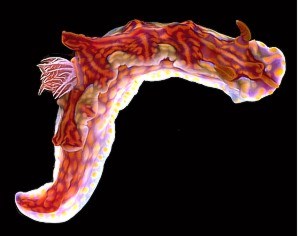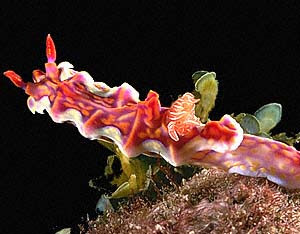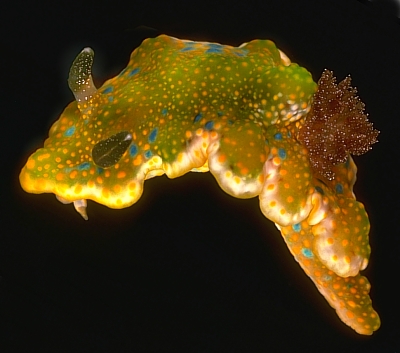
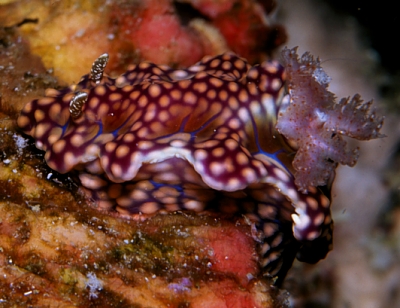
Ceratosoma sinuatum
(van Hasselt, 1824)
Order: NUDIBRANCHIA
Suborder: DORIDINA
Superfamily: EUDORIDOIDEA
Family: Chromodorididae
DISTRIBUTION
Indo-West Pacific
PHOTO
Upper: Solitary Islands, northern New South Wales, Australia, April 1987. Photo: Bill Rudman. Lower: Florida Group, Solomon Islands, November, 1999. Photo: M.J. Adams.
Note added 4 July 2007: The name is changed today from C. sinuata to C. sinuatum - see message #20101.
Until now I have, like Baba & Hamatani (1974), considered all the various coloured forms of 'Miamira' to be part of one variable species, Ceratosoma sinuatum [see message #19853] but after reviewing the available names [message #19854] I am also recognising C. flavicostatum and a group of animals which may well be Ceratosoma magnificum.
In C. sinuatum the background colour ranges from bright green to dull purplish brown and the whole body is covered with low rounded yellow tubercles. Both the gills and the rhinophores are translucent greenish or brownish - depending on the background colour - and have scattered white spots. The anterior end of the mantle is trilobed with the central lobe being much longer than the other two.
From the available information it would seem there are at least two species in this group, one with rounded tubercles and white spots on the gills and rhinophores, which is C. sinuatum, and one with a ridged pattern and distinctive white lines on the gills which can be identified as Baba's Ceratosoma flavicostatum. As mentioned above, C. magnificum may be a thrid species. [Earlier names for C. sinuatum include Doris sinuata van Hasselt, 1824 and Miamira nobilis Bergh, 1875].
-
Baba, K. (1940) Miamira flavicostata n.sp., a nudibranchiate mollusc from Amakusa, Japan. Zoological Magazine, Japan 52(6), 239-240.
-
Baba, K & Hamatani, I. (1974) On the synonymy of Miamira sinuata (van Hasselt, 1824) from Japan (Nudibranchia: Dorididae: Miamirinae). Venus, The Japanese Journal of Malacology 33 (2, August), 81-84.
-
Eliot, C.N.E. (1910) Nudibranchs collected by Mr. Stanley Gardiner from the Indian Ocean in H.M.S. Sealark. Reports of the Percy Salden Trust Expedition to the Indian Ocean in 1905, under the leadership of Mr. J. Stanley Gardiner, M.A. Transactions of the Linnean Society, Zoology, series 2, 13(2), 411-439, Pl. 25.
-
Valdes, A. & Gosliner, T. (1999) Reassessment of the systematic status of Miamira Bergh, 1875 and Orodoris Bergh, 1875 (Nudibranchia; Chromodorididae) in light of phylogenetic analysis. Journal of Molluscan Studies, 65:33-45.
Rudman, W.B., 2007 (April 30) Ceratosoma sinuatum (van Hasselt, 1824). [In] Sea Slug Forum. Australian Museum, Sydney. Available from http://www.seaslugforum.net/find/cerasinu
Related messages
Another misleading aquarium sale
November 25, 2009
From: Kevin Bott
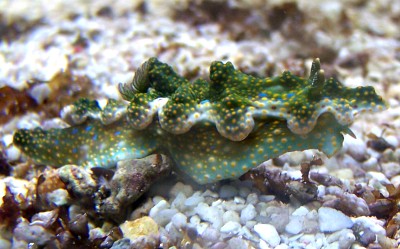
Sorry but I will now add myself to the list of stupid people who buy nudi's as one thing but then find out its another
It was sold as an algae-eating green/yellow nudi
After a 5 days of not seeing any feeding I contacted the LFS who now try and say that they only sell lettuce slugs and blue dorids
But from what i have now seen this is not a lettuce slug
could you please help with ID and food types if known
Thank you
Regards
Kev
maureen_bott1@hotmail.com
Bott, K., 2009 (Nov 25) Another misleading aquarium sale. [Message in] Sea Slug Forum. Australian Museum, Sydney. Available from http://www.seaslugforum.net/find/22837Dear Kev,
I am afraid this is no lettuce slug. It is a sponge-feeding nudibranch Ceratosoma sinuatum. Have a look at Mandi Woods' message [#22789]. She had a very similar experience - I just hope you didn't end up with the slug she returned!
As I told her, the news is not good. We are not sure what this animal eats, other than it is a sponge, probably of the Dysideidae family. I am afraid an LFS could not be trusted to deliver you with the right sponge - even if they could keep it alive. Keeping sponges alive in aquaria is very difficult. And what you want is to be able to keep a sponge alive so that a nudibranch can eat it alive. Every bit of damage the sponge would sustain would make it just that little bit more difficult for you to keep it alive in your aquarium. My advice would be to demand your money back and tell all your friends to take their business to a more ethical and/or knowledgeable business
Best wishes,
Bill Rudman
Ceratosoma sinuatum feeding?
November 16, 2009
From: Mandi Woods
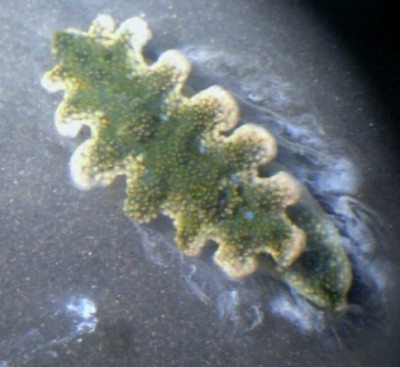
Hello
I am not sure if you can help at all, I ordered 2 Elysia crispata and my delivery arrived only to find they were not the Elysia crispata they said they were. After a lot of research I have found out that they are Ceratosoma sinuatum.
Can anyone help me in what they will eat, as although they are not what I ordered I would hate for them to starve. Any urgent advice would be greatly appreciated.
I have them in isolation at the moment, but this morning noticed this when one of the was touched by something, and is seems to have a funny smell to the tank now. Can you give me any advice as to what I should do with them. The smell gave me a headache immediately so I opened the window. I am a little bothered as they are in an isolation tanks not far from my Berghia Breeding system.
Its Saturday now so I can't return them to the person that sent them to me today. I have attached a pic (not brilliant) but best I could do.
Very keen to know if this secretion is a problem.
Kindest Regards
Mandi
k9weg@aol.com
Woods AC, 2009 (Nov 16) Ceratosoma sinuatum feeding?. [Message in] Sea Slug Forum. Australian Museum, Sydney. Available from http://www.seaslugforum.net/find/22789Dear Mandi,
I'm afraid I can't help with the food problem other than to say it will feed on sponges, and most probably a sponge of the family Dysideidae. That is the family of sponges species of Ceratosoma usually feed on, but I know of no information on C. sinuatum in particular.
Your photo of your animal streaming white secretions is very interesting. Many nudibranchs use 'nasty' chemicals to deter predators and I have discussed this in quite a few parts of the Forum. Have a look at the Chemical Ecology Fact Sheet for an introduction, and messages #723, #8859 for two more examples of chromodorids with streaming white secretions. In most species of Ceratosoma most of the defensive chemicals are stored in a large accumulation of glands in the dorsal horn. C. sinuatum is one of a few species of Ceratosoma without a dorsal horn, and where the defensive chemicals are stored has been a puzzle. From your photo it seems that, like some species of Glossodoris, they are kept in small sacs scattered over the skin, and so when disturbed the animal exudes this white secretion all over the body.
Your description of a strange smell giving you a headache is also interesting. I have not heard of anyone experiencing that before with a chromodorid, but species of Phyllidia, Phyllidiella and their relatives kept in aquaria can do that [see my comment in message #433]. The smell is almost certainly caused my one of the chemicals exuded from the slug. I know from experience that the secretions from phyllidiids can kill everything in an aquarium, but I can't say for certain with this Ceratosoma.
Best wishes,
Bill Rudman
Ceratosoma sinuata from Reunion Is.
February 5, 2009
From: Sully Bachel
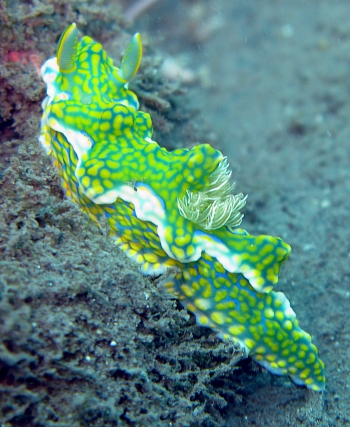
Dear Bill
Here is a beautiful Ceratosoma sinuata crawling over a sandy place
Locality: La Possession, 6 m, Reunion Island, Indian Ocean, 28 December 2008. Length: 45 mm. Photographer: Sully Bachel.
best regards
Sully Bachel
s.bachel@orange.fr
Bachel, S., 2009 (Feb 5) Ceratosoma sinuata from Reunion Is.. [Message in] Sea Slug Forum. Australian Museum, Sydney. Available from http://www.seaslugforum.net/find/22189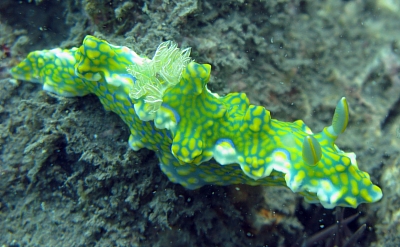
Dear Sully,
Although everything seems to be covered in a layer of fine sediment, it seems to be covering algae, and colonies of sponge and other invertebrates.
Best wishes,
Bill Rudman
Ceratosoma sinuatum from East Timor
January 8, 2009
From: Brian Francisco
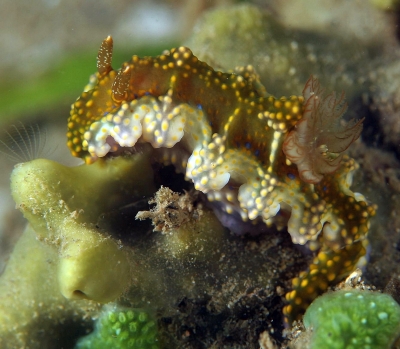
Concerning message #20963:
Hi Bill
Here are a few shots of Ceratosoma sinuatum that we found this week. Our last sighting of C. sinuatum was nearly four years ago.
Locality: Tasi Tolu, 6 meters, East Timor, Banda Sea, 31 December 2008, sandy slope. Length: 2cm. Photographer: Brian Francisco.
Brian
francisco.brian@gmail.com
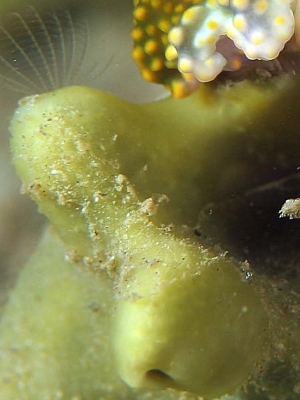
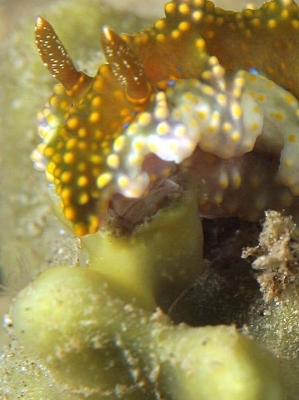
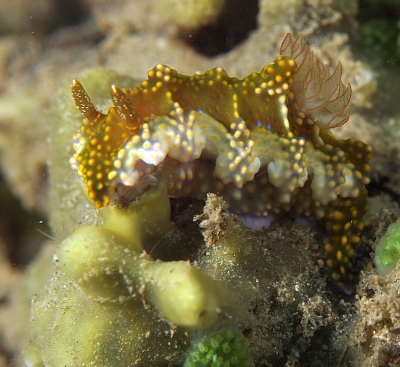
Dear Brian,
As with Carlos Munda's message, yours also has a possible sponge food, but as it it quite different from the one in hhis photos, I guess we can only wait for another find. As you suggest, this species does not appear to be commonly seen, but I can't say whether that is because it is rare or just because it is good at hiding itself.
Best wishes,
Bill Rudman
Ceratosoma sinuatum from the Philippines
April 7, 2008
From: Carlos Munda
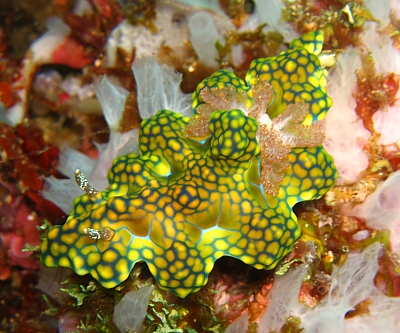
Can you please help me identify this Halgerda? The photo was taken by a firend of mine near Samal Island.
Locality: Malipano, Samal Island, 30 feet, Philippines, Davao Gulf, 06 October 2007, Muddy. Photographer: Felix.
Thanks
Carlos Munda
c_munda@yahoo.com
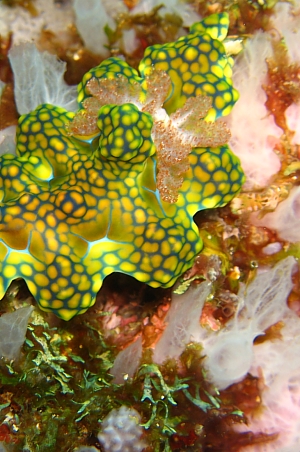
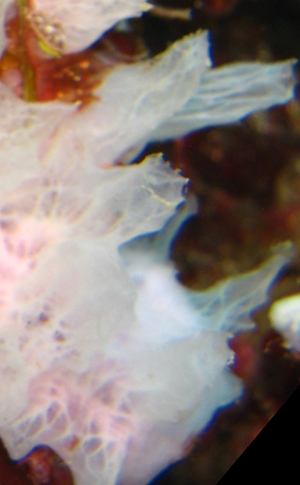
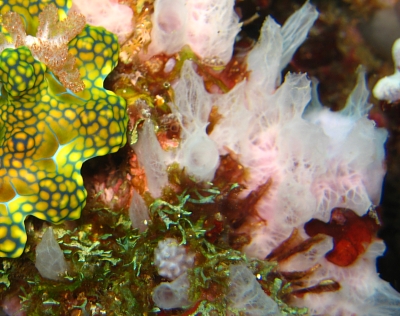
Dear Carlos,
This is a very nice photo of Ceratosoma sinuatum. The body certainly looks a bit like a species of Halgerda but it is a species of Ceratosoma. Species of Ceratasoma have the bright colours of the chromodorids, but a much tougher outer body wall, more lie that found in Halgerda. I have included a number of close-ups of parts of Felix's photo because it shows a very interesting sponge colony which could well be the food of this species. The arrangement of the fibres in the sponge suggest it is a dysideid, which some other species of Ceratosoma feed on, but the large siphon-like out-growths all over the colony are very unusual. I will have to pass this on to a sponge expert for comment.
This is the first indication we have of a food sponge for this species so even though I can't instantly identify it it is a valuable first step.
Best wishes,
Bill Rudman
Name changes in Ceratosoma
July 5, 2007
From: Bill Rudman
In Gary Cobb's recent message [#20098] he uses the spelling Ceratosoma sinuatum for the species which has usually been called Doris sinuata or Miamira sinuata in the scientific literature, and I have been calling Ceratosoma sinuata on the Forum. Gary and Richard Willan used the same spelling [sinuatum ] in their recent book Undersea Jewels - A colour guide to Nudibranchs and also changed the spelling of Ceratosoma magnifica to C. magnificum. Unfortunately they make no comment on these changes in their book and I note on websites a certain amount of confusion is already growing because people don't know if this is a spelling error by them or what?
Their spelling is in fact correct. They are just following the International Code of Zoological Nomenclature which unfortunately puts adherence to the grammar of dead languages ahead of name stability. Under the Rules, the gender of the species part of the name must match the gender of the genus part of the name. This is particularly incomprehensible to English speakers whose language does not have gender-based words. While I accept we need some rules when a name is made for a new species, a real problem arises when research shows that a species should be moved to another genus. If the new genus name is of a different gender then the ending of the species part of the name needs to change.
In this case Ceratosoma has a Greek derivation and is neuter. This means that, the following species which have all changed genera since being described need a spelling revision:
Ceratosoma amoena should be Ceratosoma amoenum.
Miamira flavicostata should be Ceratosoma flavicostatum
Miamira sinuata should be Ceratosoma sinuatum
Miamira magnifica should be Ceratosoma magnificum
Orodoris miamirana should be Ceratosoma miamiranum
Please don't send Richard and Gary any hatemail - they are just following the Rules. As you may have guessed I find this need to change the endings of names when generic placements change quite ridiculous.With our growing dependence on computerised databases, a rule that forces names to change at the whim of the latest phylogenetic hypothesis is not helpful. I have recently discussed why we retain 4 or 5 different spellings of names based on Eduard Rüppell [message #1998] to ensure 'stability' yet here we have a rule which ensures instability by insisting on names changing to match the gender of their 'new' genus whenever a phylogenetic change is made.
Bill Rudman
Rudman, W.B., 2007 (Jul 5) Name changes in Ceratosoma. [Message in] Sea Slug Forum. Australian Museum, Sydney. Available from http://www.seaslugforum.net/find/20101Ceratosoma sinuatum from southern Queensland, Australia
July 5, 2007
From: Gary Cobb
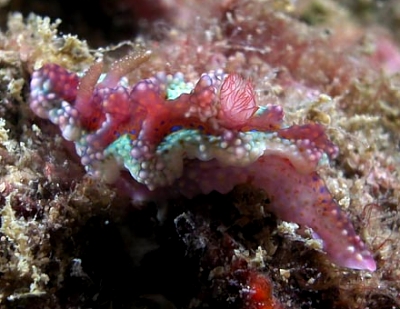
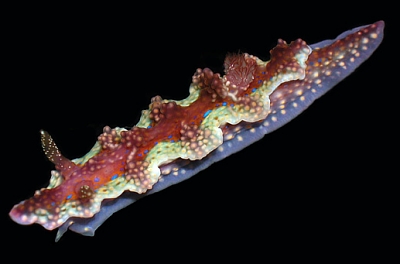
Hi Bill!
Here is the first Ceratosoma sinuatum David and I have found here on the Sunshine Coast, Queensland, Australia. This animal was found at Old Woman Island near Mooloolaba. I think it is interesting that this animal is green as an adult and red as a juvenile ... but here we have transitioning teenager with both colours! I thought it might be a good addition to the Forum. Richard found an animal earlier at Noosa, so it is great to finally find one here. The colours and shapes of this animal make it a very exciting visual treat!
Locality: Sunshine Coast near Mooloolaba, 12m, Queensland, Australia, Pacific Ocean, 30 June 2007, Subtidal. Length: 26mm. Photographer: David Mullins and Gary Cobb.
Cheers and happy branching!
Gary
gary@nudibranch.com.au
Cobb, G.C., 2007 (Jul 5) Ceratosoma sinuatum from southern Queensland, Australia. [Message in] Sea Slug Forum. Australian Museum, Sydney. Available from http://www.seaslugforum.net/find/20098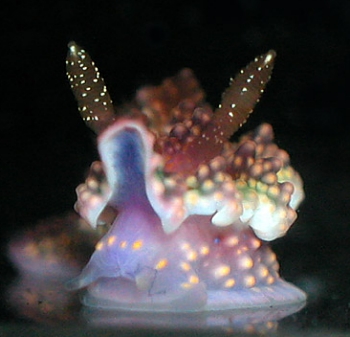
Thanks Gary,
It would be nice to say that this species changes from red to green as it grows but I know of no evidence to support that. Certainly the examples on the Forum don't follow that hypothesis. If I have missed some research on that could you let me know please?
Bill Rudman
Ceratosoma sinuata from Komodo area
June 1, 2007
From: Marli Wakeling
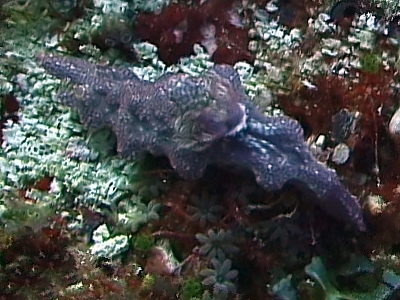
Hi Bill,
I have a video clip of a nudibranch taken by a friend while diving near Komodo: to the east on a small islet called "Deadman Island". It looks like it might be a Ceratosoma, but I haven't been able to ID it for him. I have sent a still from a video, but of course the still is poor in quality. Any idea what this may be?
Locality: Deadman Island, Komodo National Marine Park, Nusa Tenggara, Indonesia. Depth: 65 feet. Length: 3 cm. 22 February 2005. rubble Photographer: Robert Ross
Cheers,
Marli Wakeling
scubamarli@gmail.com
Wakeling, M., 2007 (Jun 1) Ceratosoma sinuata from Komodo area. [Message in] Sea Slug Forum. Australian Museum, Sydney. Available from http://www.seaslugforum.net/find/15113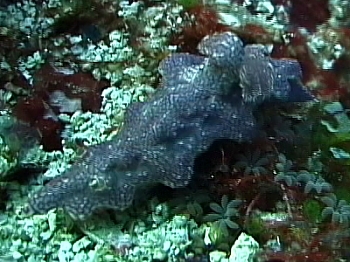
Dear Marli,
I have had your message a while, so it may no longer be a mystery to you. It is Ceratosoma sinuata which I had a bit to say about quite recently.
Best wishes,
Bill Rudman
Re: Ceratosoma sinuata from Clovelly, Sydney
May 1, 2007
From: Salvador C Tan

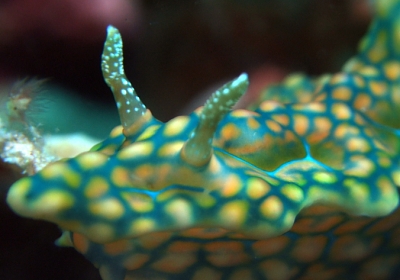
Concerning message #3226:
Dear Bill,
I got your contact from Digidiver.net. I was looking for the name of the nudi I found in Panglao Island, Bohol, Philippines. They were quick to respond and gave me the name...
Locality: Panglao Island, Bohol, 18-20meters, Philippines, Philippine Sea, 7 April 2007, Reef, wall, . Length: 7.5cm-8cm. Photographer: Salvador Tan.
Salvador Tan
doytan@gmail.com
Tan, S.C., 2007 (May 1) Re: Ceratosoma sinuata from Clovelly, Sydney. [Message in] Sea Slug Forum. Australian Museum, Sydney. Available from http://www.seaslugforum.net/find/19827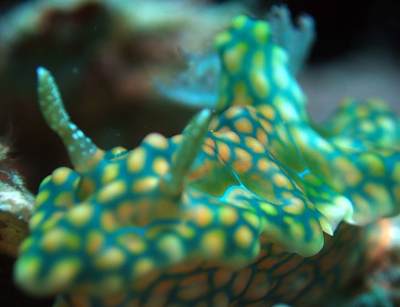
Dear Doy,
Yes this is Ceratosoma sinuata
Best wishes,
Bill Rudman
Ceratosoma sinuata from Sulawesi
December 21, 2002
From: Mary Jane Adams
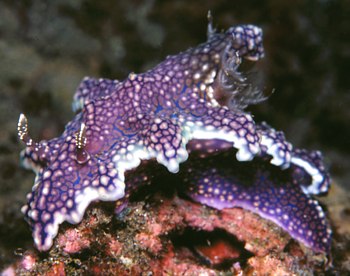
Hi Bill,
I believe this is an usual color morph of Ceratosoma sinuata. It was larger than most; about 6-8cm long. The divesite was Magic Crack, Lembeh Strait, Sulawesi Island, Indonesia. Depth: 18 meters, November 26, 2002.
It is hard to believe that this same species is known as the "Jolly Green Giant" in Hawaii. I think a better nickname for this one would be "Purple People Eater."
Best regards,
Mary Jane
divepng@yahoo.com
Adams, M.J., 2002 (Dec 21) Ceratosoma sinuata from Sulawesi. [Message in] Sea Slug Forum. Australian Museum, Sydney. Available from http://www.seaslugforum.net/find/8659Note added 30 April 2007: Until now on the Forum C. sinuata and C. flavicostata have been considerd forms of one species. See message #19854 where they and C. magnifica are considered separate species.
Thanks Mary Jane,
I agree that its hard to believe they're all the same species. The problem is where to draw the line. I think this is could be nice little topic for a graduate student. I've often wondered about the name "Jolly Green Giant". I think the name was also used for a 'species' of helicopter in the Vietnam war. Anyone know of a connection?
Cheers,
Bill Rudman
Ceratosoma sinuata from Hawaii
May 27, 2001
From: Andy Woerner
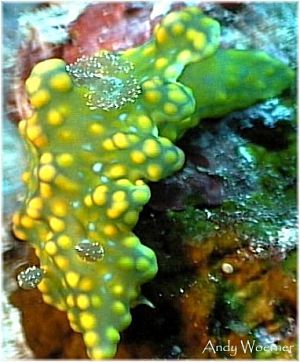
Aloha Bill,
To accompany the photos of Kalinga ornata here is a photo of my first Ceratosoma sinuata. I found it yesterday [16 May 2001] at "Henry's Cave" (Also on the Big Island of Hawaii) but didn't have a camera. I went back the next day and found it about 4 feet from where it was before ... of course it took me an hour and fifteen minutes to find him again ... but I shot about 10 minutes of video. I included a shot that I pulled from the footage.
Andy Woerner
andywoerner@hotmail.com
Woerner, A., 2001 (May 27) Ceratosoma sinuata from Hawaii. [Message in] Sea Slug Forum. Australian Museum, Sydney. Available from http://www.seaslugforum.net/find/4415Note added 30 April 2007: Until now on the Forum C. sinuata and C. flavicostata have been considerd forms of one species. See message #19854 where they and C. magnifica are considered separate species.
Thanks Andy,
The Hawaiian animals seem to be a very bright green. By the way, did you see my recent message about the long-lost Chromodoris petechialis. If you are a keen nudibranch hunter it would a interesting animal to find again.
Best wishes,
Bill Rudman
Avoidance behavior in Ceratosoma sinuata
January 27, 2001
From: Mary Jane Adams
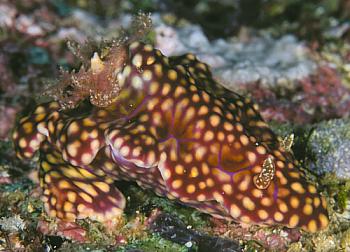
Hi Bill,
I found this Ceratosoma sinuata sitting on a rock at 22 meters in the Florida Islands in November, 2000. When I started shooting, it started rotating away from me. I had to keep moving around the rock to keep it's "face" in the picture. I also noticed this same apparent avoidance behavior with the Halgerda batangas I photographed a few days earlier. It was not moving until my strobes started firing, then it began to turn away from me.
The C. sinuata showed another behavior that I interpreted as agitation or possibly threat posturing. It was rapidly withdrawing and extending it's rhinophores. At first I thought it was a reflexive reaction to my strobes. The rhinophores withdraw immediately after each shot, but also every few seconds between shots.
Most nudibranchs I photograph appear totally unaware of me. These two, however definitely showed signs of trying to avoid the blast of intense light (and possibly heat?) from my stobes. Has anyone studied the reaction to noxious stimuli in sea slugs?
Best regards,
Mary Jane
divepng@yahoo.com
Adams, M.J., 2001 (Jan 27) Avoidance behavior in Ceratosoma sinuata. [Message in] Sea Slug Forum. Australian Museum, Sydney. Available from http://www.seaslugforum.net/find/3552Note added 30 April 2007: Until now on the Forum C. sinuata and C. flavicostata have been considerd forms of one species. See message #19854 where they and C. magnifica are considered separate species.
Dear Mary Jane,
Many sea slugs appear to be negatively phototactic, that is they move away from a light source. A major irritation when you are trying to draw them under a microscope. Since many opisthobranchs are active at night, apparently to avoid the attention of predators, a built-in behaviour which caused them to move away from light would cause them to move into shade (that is under rocks etc) and so into hiding. That is why cloudy overcast days are better for intertidal and tide-pool collecting them bright summer days.
Opisthobranch eyes seem only able to sense light and dark. This does allow them to sense shadows passing over them. I have certainly experienced animals withdrawing their rhinophores and gills when I have caused a shadow to pass over them. This is again probably a useful defence is a fish is about to have an investigatory nibble. I suspect the rapid withdrawal and extension of rhinophores may be a 'short circuit' in their nerve reflexes. I don't suppose their nervous system has evolved with bright strobes in mind.
The only systematic study of behaviour in sea slugs I know of is Eric Kandel's pioneering work on Sea Hares. He eexhaustively tested and described in minute detail their nervous system's response to all sorts of stimuli so that he had some base line data for his investigation into the workings of their primitive nervous system. I like to think his award this year of a Nobel Prize means that a sea slug worker has hit the big time. You'll find references to is two books, which I often refer to in an earlier message. That message also refers to Rhanor Gillette's website and lab where research on sea slug behaviour is also being conducted.
Bill Rudman
Ceratosoma sinuata from Clovelly, Sydney
October 24, 2000
From: Donata P. & Akos L.
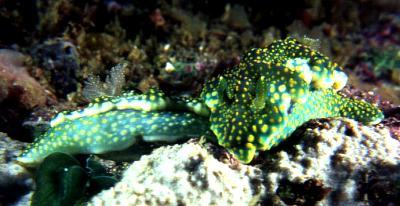
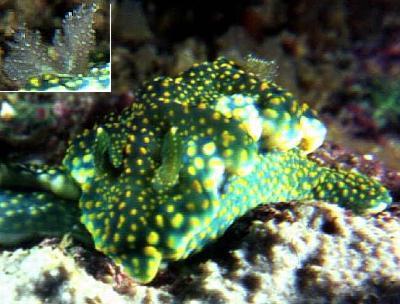
Dear Bill,
Here is the Ceratosoma sinuata that we mentioned in our recent message. Location: Shark Point, Clovelly, Sydney [New South Wales, Australia] Dec 1998 -April 1999. The grey sponge upon which the specimens are has had up to six specimens of both "sinuata" and "magnifica" colour forms the same few months. No camera handy at the time of course. TYPICAL.
Anyway, if we find them again on the same rock shortly, it will be three years in a row!!!!!
Regards
Akos & Donata
dna72@softhome.net
Piotrowska, D. & Lumnitzer, A. , 2000 (Oct 24) Ceratosoma sinuata from Clovelly, Sydney. [Message in] Sea Slug Forum. Australian Museum, Sydney. Available from http://www.seaslugforum.net/find/3226Note added 30 April 2007: Until now on the Forum C. sinuata and C. flavicostata have been considered forms of one species. See message #19854 where they and C. magnifica are considered separate species.
Thanks Akos & Donata,
I'll post your photos of the other colour form tomorrow. This green form is characterised by the white spots on the gills.
Best wishes,
Bill Rudman.
Re: Ceratosoma sinuata from the Solomon Ids
October 24, 2000
From: Mary Jane Adams
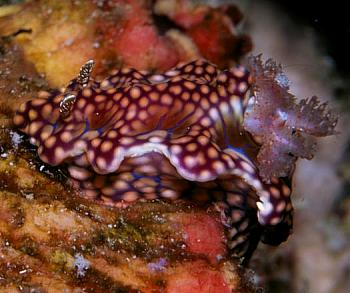
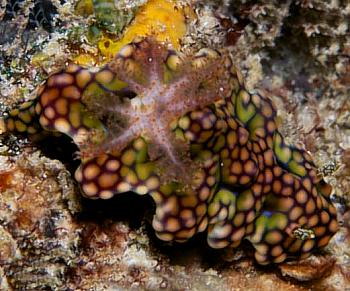
Note added 30 April 2007: Until now on the Forum C. sinuata and C. flavicostata have been considered forms of one species. See message #19854 where they and C. magnifica are considered separate species.
Dear Bill and Scott,
Here are images of two more Ceratosoma sinuata from the Solomon Islands. I shot them both in the Florida Group in November, 1999.
UPPER PHOTO is from the divesite known both as "Velvia" and "Baby Cakes." This is the same reef where Bruce shot his green one.
LOWER PHOTO is from the Southeast side of Anuha Island.
I will be back in the Solomons next week, so maybe I can find some more.
Best regards,
Mary Jane
mjadams@earthlink.net
Adams, M.J., 2000 (Oct 24) Re: Ceratosoma sinuata from the Solomon Ids. [Message in] Sea Slug Forum. Australian Museum, Sydney. Available from http://www.seaslugforum.net/find/3225Thanks Mary Jane,
Yours is one of a number of very quick reponses to Scott's query.
Best wishes,
Bill Rudman.
Another Ceratosoma sinuata from Solomons
October 24, 2000
From: Buce Potter
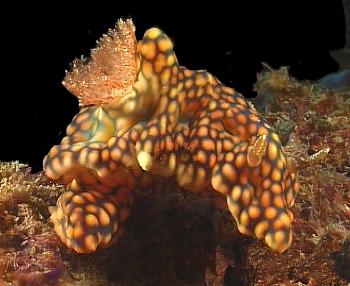
Bill,
I was very interested in the message from Scott Johnson about the "Sinuata". I have seen his photographs of this creature in a couple of books I got recently. Here is one more picture of the pink/orange one I have been watching here for the past few weeks.
This angle shows a greenish colour around the gill area.
Bruce Potter.
bruce.potter@adventist.org.sb
Potter, B., 2000 (Oct 24) Another Ceratosoma sinuata from Solomons. [Message in] Sea Slug Forum. Australian Museum, Sydney. Available from http://www.seaslugforum.net/find/3231Note added 30 April 2007: Until now on the Forum C. sinuata and C. flavicostata have been considerd forms of one species. See message #19854 where they and C. magnifica are considered separate species.
Thanks Bruce,
This looks very much like the animals photographed by Mary Jane. One thing worth looking at in these Solomons animals is that whether the ground colour is green or brownish, the gills all have little orange specks. Other forms or 'species' of this group have white specks and others have lines. I don't know what it all means at this stage but I have found before in chromodorids that an apparently minor colour diference can prove an important marker in separating species.
Best wishes,
Bill Rudman.
Three versions of Ceratosoma sinuata
October 23, 2000
From: Scott Johnson
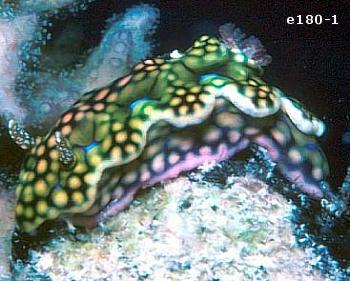
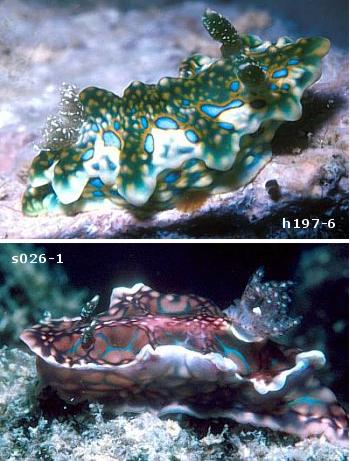
Note added 30 April 2007: Until now on the Forum C. sinuata and C. flavicostata have been considered forms of one species. See message #19854 where they and C. magnifica are considered separate species.
Hi Bill,
Attached are three versions of Ceratosoma sinuata from Hawaii (h197-6), the Marshall Islands (e180-1), and the Solomons (s026-1). I notice from the Forum that at least in Australia there seems to be some overlap between color forms (or species) in the same locale. Based on very limited sample
sizes, this may not be the case in the Marshalls and Hawaii. Both of the individuals of this species I found in Hawaii looked like h197. The 8 specimens from the Marshalls all resembled e180. I saw only the one specimen in the Solomons. Do you know if much color variation is present in other localized populations?
Scott
johnson@kmr.ll.mit.edu
Johnson, S., 2000 (Oct 23) Three versions of Ceratosoma sinuata. [Message in] Sea Slug Forum. Australian Museum, Sydney. Available from http://www.seaslugforum.net/find/3223Dear Scott,
By coincidence, your message arrived when I was posting Bruce Potter's from the Solomons. His two colour forms do seem to be variations on one shape but I don't know of we could fit your Solomon's animal into the mold as well.
As I see more photos of these animals I, like you, are slightly hesitant to lump them all together. I can say that in New Caledonia, as in eastern Australia all colour forms and shapes occur. I don't have enough records from elsewhere to say anything sensible. Any comments from others would be welcome.
Best wishes,
Bill Rudman.
Ceratosoma sinuata from the Solomon Ids
October 19, 2000
From: Bruce Potter
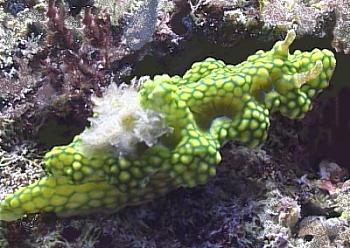
Note added 30 April 2007: Until now on the Forum C. sinuata and C. flavicostata have been considered forms of one species. See message #19854 where they and C. magnifica are considered separate species.
Bill,
I have found several examples of the "normal" green form of Ceratosoma sinuata over the years.
Yesterday I found a pink form, which I have only ever seen once before. The only other time I have found it was about 10 months ago, on exactly the same bommy. Surely it cannot be the same individual can it? I check this particular bommy every week, and have not seen the creature for 10 months. It appears to be the only one on the bommy, just as I only found one there last time.
This is at about 15 meters, on a rubble and coral site.
I have included a picture of a green one I found at "Velvia" in the Florida Islands (Solomons), and two of the red one I filmed off Honiara yesterday.
Bruce Potter
bruce.potter@adventist.org.sb
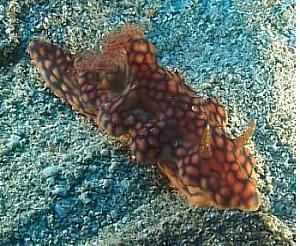
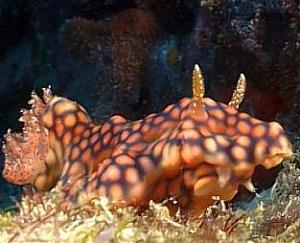
Dear Bruce,
Thanks for the beautiful photos which show the shape so well. And to your question about how long they live and whether they would stay at the same spot for 10 months or more. By coincidence I have recently received the identical question from Donata and Akos about a similar occurrence in Sydney.
Have a look at my answer to them. I don't know how many different people need to make a similar observation before I begin to think they do stay in the same spot for over a year, but it is certainly interesting.
Best wishes,
Bill Rudman.
Ceratosoma sinuata? from Thailand
May 11, 2000
From: Narongpon Sittithaweepat
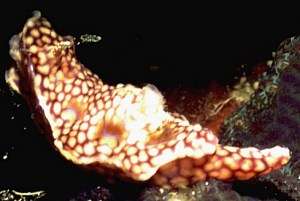
Dear Bill
I can't identify this nudibranch. I found it at Surin Island, Thailand and photo by Dr. Thon Thamrongnawasawat. I don't record date and depth.
Thank you
Narongpon Sittithaweepat
chromodorid@thaimail.com
Sittithaweepat, N., 2000 (May 11) Ceratosoma sinuata? from Thailand. [Message in] Sea Slug Forum. Australian Museum, Sydney. Available from http://www.seaslugforum.net/find/2235Note added 30 April 2007: Until now on the Forum C. sinuata and C. flavicostata have been considered forms of one species. See message #19854 where they and C. magnifica are considered separate species.
Dear Narongpon,
I think this is probably a colour form of the 'Miamira' group of 'species' which is now considered to be just one variable species of Ceratosoma, C. sinuata.
Best wishes,
Bill Rudman.
Ceratosoma sinuata from Okinawa, Japan
February 13, 2000
From: Kazuko Matsuda
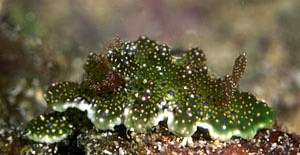
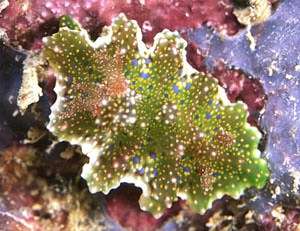
Note added 30 April 2007: Until now on the Forum C. sinuata and C. flavicostata have been considered forms of one species. See message #19854 where they and C. magnifica are considered separate species.
Dear Bill
This is the Ceratosoma sinuata I found at the same point I saw the juveniles of the 'Miamira - group'.
Data:depth:20m, length:30mm
21 November 1999(upper image)
28 November 1999(lower image)
Kazuko
matsu@ii-okinawa.ne.jp
Matsuda, K., 2000 (Feb 13) Ceratosoma sinuata from Okinawa, Japan. [Message in] Sea Slug Forum. Australian Museum, Sydney. Available from http://www.seaslugforum.net/find/1877Dear Matsuda,
Thanks for the photos. In the lower photo the nudibranch seems to be eating the bluish sponge. If so this is probably the first feeding record.
Best wishes,
Bill Rudman.
Two juveniles of 'Miamira-group' from Okinawa
February 2, 2000
From: Kazuko Matsuda
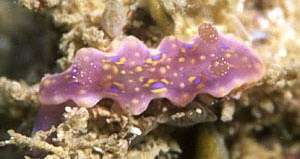
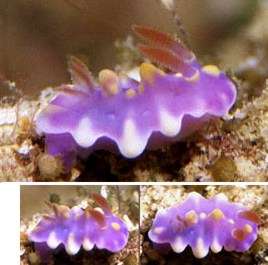
Dear Bill
Thank you for your reply to my last message.
Two juveniles of 'Miamira-group' were found at Sunabe in Okinawa, Japan. There are some rocks in sand, 10m away from reef edge, they were on rocks there. One of them is a color variation of 'Ceratosoma sinuata', but I don't know the other. Could you identify it for me?
Data:
UPPER PHOTO: ('sinuata') 21 December 1999, depth: 20m, length: 9mm
LOWER PHOTOS: (unknown) 25 December 1999, depth: 20m, length: 6mm(two images)
Green type 'sinuata'(22mm) and Ceratosoma miamirana (30mm) were also found at the same point(within a 2-meter radius).
Kazuko
matsu@ii-okinawa.ne.jp
Matsuda, K., 2000 (Feb 2) Two juveniles of 'Miamira-group' from Okinawa. [Message in] Sea Slug Forum. Australian Museum, Sydney. Available from http://www.seaslugforum.net/find/1826Note added 30 April 2007: Until now on the Forum C. sinuata and C. flavicostata have been considered forms of one species. See message #19854 where they and C. magnifica are considered separate species.
Dear Kazuko,
These are beautiful animals. I agree that the top one looks like a purple colour form of the green 'sinuata' but the lower photos look a bit different, though they do look a bit like 'magnifica' in shape.
At this stage I guess its a question of building up more information. It would be interesting to see if you find large specimens of these purple colour forms or whether they change into less colourful adults.
I would be interested in photos of the larger species you also saw. They would be an interesting comparison.
Best wishes,
Bill Rudman.
Re: Ceratosoma (=Miamira) sinuata from Sydney
October 23, 1999
From: Erik Schloegl
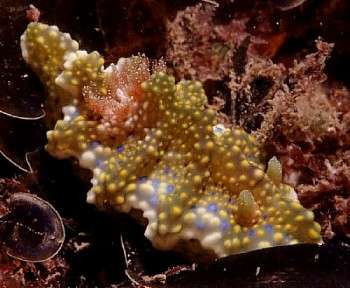
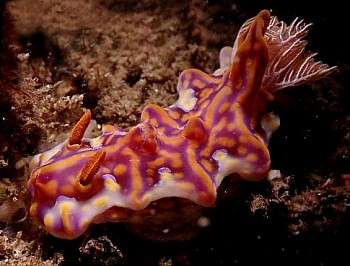
Note added 30 April 2007: Until now on the Forum C. sinuata and C. flavicostata have been considered forms of one species. See message #19854 where they and C. magnifica are considered separate species.
Hi all,
I just couldn't resist posting this reply to brag about Sydney's nudi diversity - and I don't mean the Mardi Gras :-) Appended are two variations from theCeratosoma/Miamira sinuata/magnifica group. The UPPER image was taken off the northern Sydney suburb of Dee Why, on a rocky reef at a depth of approx. 25m. The LOWER image was taken at a dive site called Colours Reef, a few hundred meters south of the entrance to Sydney Harbour, also at a depth of about 25m, on rocky reef.
Erik Schloegl
schloegl@maths.uts.edu.au
Schloegl, E., 1999 (Oct 23) Re: Ceratosoma (=Miamira) sinuata from Sydney. [Message in] Sea Slug Forum. Australian Museum, Sydney. Available from http://www.seaslugforum.net/find/1451Thanks Erik,
Bill Rudman.
Ceratosoma (=Miamira) sinuata from Maldives
October 19, 1999
From: E. Koehler
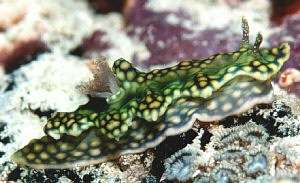
Bill,
Here is Miamira sinuata from the Maldives, Ellaidhoo Island, housereef, November 19, 1996, size 4,5 cm, depth 12 m.
Erwin.
Medslugs.Koehler@t-online.de
Koehler, E., 1999 (Oct 19) Ceratosoma (=Miamira) sinuata from Maldives. [Message in] Sea Slug Forum. Australian Museum, Sydney. Available from http://www.seaslugforum.net/find/1429Note added 30 April 2007: Until now on the Forum C. sinuata and C. flavicostata have been considered forms of one species. See message #19854 where they and C. magnifica are considered separate species.
Thanks Erwin,
This gives me a reason to update theMiamira sinuata page following Valdes & Gosliner's paper this year, suggesting that Miamira should be considered a synonym of Ceratosoma. I had often considered moving Miamira to the Chromodorididae, but fully concur with their decision to go a step further and synonymise the genus Miamira with Ceratosoma. As I have discussed at the top of the page, just how many species are in the 'Miamira sinuata-group' is still not clear.
Bill Rudman.
Ceratosoma sinuata Fact Sheet
October 18, 1999
From: Bill Rudman
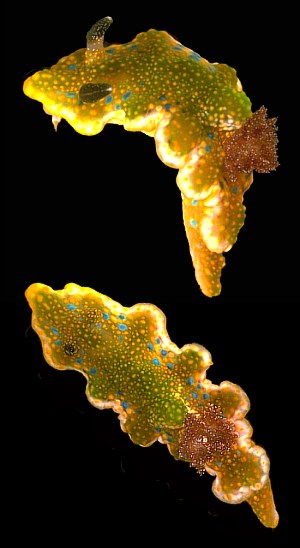
NOTE: This Fact Sheet is no longer current. It was originally posted on 18 October 1999 and replaced on 27 April 2007. It is retained here for archival purposes only.
===================
Ceratosoma sinuata
(van Hasselt, 1824)
Order: NUDIBRANCHIA
Suborder: DORIDINA
Superfamily: EUDORIDOIDEA
Family: Chromodorididae
DISTRIBUTION
Found throughout the tropical and subtropical Indo-West Pacific.
PHOTO
UPPER RIGHT: Two views of typical 'sinuata colour form. Solitary Islands, northern New South Wales, Australia, April 1987.
LOWER PHOTOS: Two 'flavicostata/magnifica' colour forms - LEFT: Solitary Islands, northern NSW, May 1987; - RIGHT: Coffs Harbour region, northern New South Wales, November 1990. PHOTOS: Bill Rudman
Formerly placed in the genus Miamira, Valdes & Gosliner (1999) have recently proposed that these animals are members of the chromodorid genus Ceratosoma. The number of species in the 'Miamira-group' is still not clear. Some authors, such as Baba & Hamatani (1974), consider there is a single species which ranges from the green 'sinuata' form to the purplish 'flavicostata form. Others consider there are sufficient distinctions in external shape and colour, and radular morphology, to distinguish two or three species. While the extremes are very clear, there are many intermediate forms which suggest perhaps a continuum. At present I have placed them all as a single species, but this is through lack of knowledge rather than through some great insight.
Reference:
• Valdes, A. & Gosliner, T. (1999) Reassessment of the systematic status of Miamira Bergh, 1875 and Orodoris Bergh, 1875 (Nudibranchia; Chromodorididae) in light of phylogenetic analysis. Journal of Molluscan Studies, 65:33-45.
